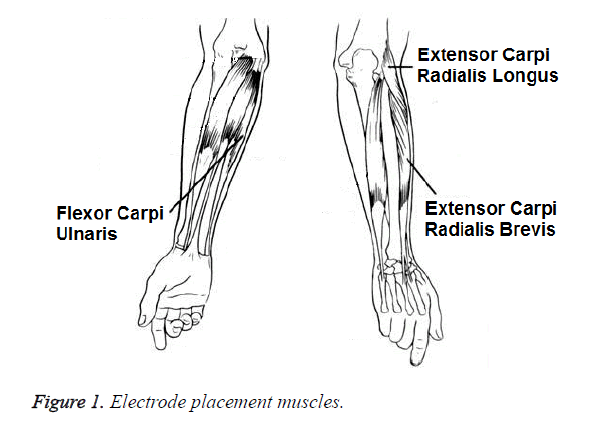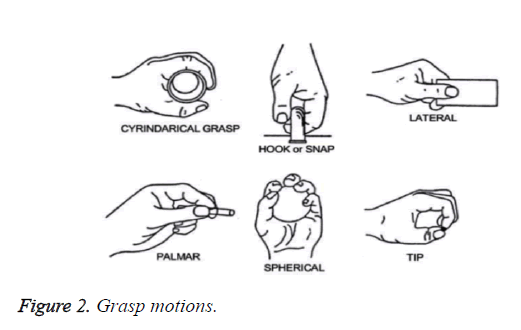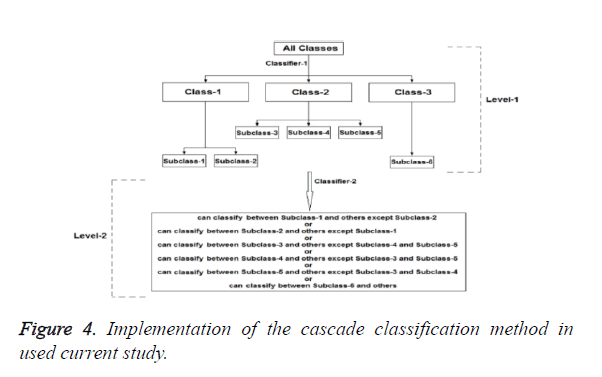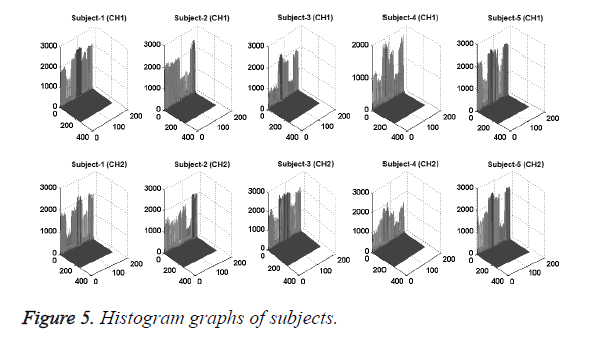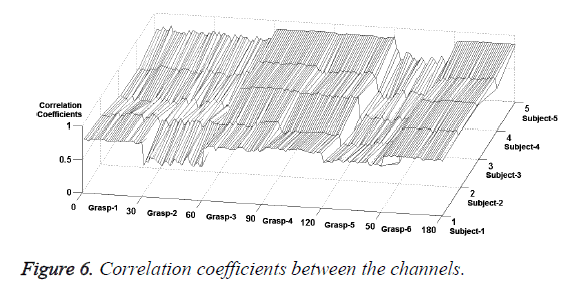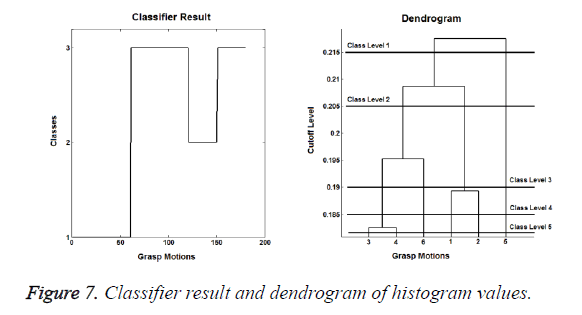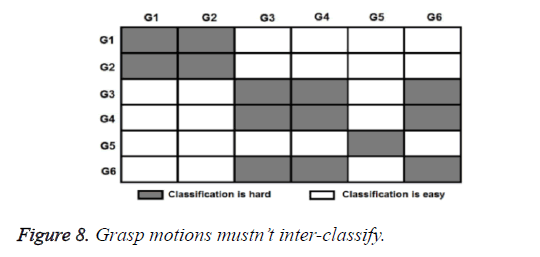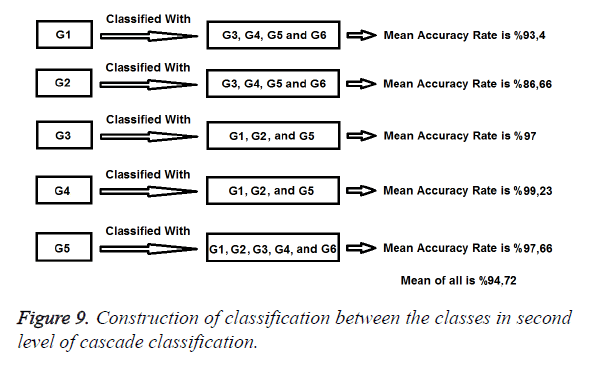Research Article - Biomedical Research (2017) Volume 28, Issue 2
Low-cost and easy-to-use grasp classification, using a simple 2-channel surface electromyography (sEMG)
Selahaddin Batuhan Akben*Bahce Vocational School, Osmaniye Korkut Ata University, Osmaniye, Turkey
- *Corresponding Author:
- Selahaddin Batuhan Akben
Bahce Vocational School
Osmaniye Korkut Ata University, Turkey
Accepted on June 02, 2016
Abstract
Aim of this study is the easy and low-cost classification of basic hand grasp motions. For this aim, two sEMG sensors were placed on the forearm muscles. The reason is that to place the sensors on two forearm muscles is a low-cost and easy method. Also these forearm muscles are related with grasp motions. At first stage of the study, feature extraction methods were applied to the energy values of two channel signals. The feature extraction methods used at first stage were the filtering and histogram calculation. Then, the relations (correlations) between the histogram values were calculated by concordance correlation method. Finally, the concordance correlation values were used to classifier as input. The cascaded-structure classifier was used to obtain best results. According to the classification results, the average success rate calculated as 94.72%. Based on this high success rate, the method used in the study is proposed to some medical decisions, such as detection of muscle disorders or graspmuscle relation.
Keywords
Surface electromyography, 2-channel hand grasp classification, Concordance correlation, Cascaded-structure classifier.
Introduction
The human hand has six basic grasp motions. These grasp motions are related with the motion of many muscles [1]. Physical characterization of these related muscles is necessary to some medical decisions, such as detection of grasp disorders, muscle disorders or grasp-muscle relations [2,3]. In addition, the physical characteristic of grasp motions provides the information related to prosthetic design [4]. On the other hand, the electrical characteristic of muscles is related with the physical characteristic of muscle motions. Therefore measuring the electrical characteristics of muscles is also needed to physical characterization of grasp motions [5]. Surface EMG (sEMG) is an important device that measures the electrical characteristic of muscles. Characterization of grasp motions can be done by measuring the electrical characteristics of the muscles related with the grasp motions [6]. Although limited in number in the literature, there are some studies based on the correlation between the grasp motions and electrical activities (characteristics) of muscles. But these studies in the literature generally are for prosthesis production [7-12]. They are therefore based on the multi-sensor measurements. But the preference of multiple-sensors cause the difficult-to-use and high-cost beside the long processing time [13,14].
In these studies, two main measurement sources (muscle regions) are used to obtain electrical signals using sEMG device. These regions are named as the hand and forearm muscles. But the forearm muscles are preferred rather than the hand muscles [15]. The reason for this preference is the forearm muscles are stationary at required level while the hand muscles are moving during the grasp motions [16,17]. As a result of this problem, the hand muscle movements make the electrode placement difficult and require the special electrodes. Therefore, to place sEMG electrodes (sensors) on the hand muscles is not a low-cost and simple way. In addition, studies in the literature have preferred the forearm muscle measurements because of the based on the production of prosthesis. As mentioned above, results of the studies in the literature are still lacking in terms of easy-to-use and low-cost. Also the priorities of them are not support the medical decisions. Furthermore, there are very few studies related with grasp motions. As a result of these shortcomings, current study aims the low-cost and easy-to-use classification method for the grasp motions by using 2-channel simple sEMG system. Also the current study aims to develop an accurate sEMG-based sensing system by describing methods to reduce the recognition error.
In the first phase of the study, the number and placement of electrodes were determined. Electrodes were placed on the forearm muscles on the basis of the studies in literature and the purpose of current study. The number of electrodes chosen was 2, to support the low-cost and easy-to-use terms. Also, at least two electrodes are needed to measure the correlation between two different muscles. In the second phase of the study, the aim was to increase the success rate. Therefore the feature extraction processes were performed in the time domain.
Energy histograms and inter-channel correlation calculations were the feature extraction methods used in this study. In addition, since it is difficult to classify the similar motions, the cascade classification method was chosen as classification method.
Material and Methods
Instruments
The hardware used was an NI analog/digital conversion card NI USB- 009, mounted on a PC. The signals were taken from two differential EMG sensors. The signals were transmitted to a 2-channel EMG system by Delsys Bagnoli, Handheld EMG Systems. Electrodes used are Delsys Trigno Mini Sensors (Dimension of each electrode is 25 × 12 × 7 mm). This type of electrode is designed for use in the treatment and diagnosis of disease. Sampling rate of data was 500 Hz. The signals were band-pass filtered using a Butterworth Band Pass Filter. The low and high cut-off frequency was 15 Hz and 500 Hz respectively. Also, a notch filter at 50 Hz was used to eliminate line interference artefacts. Surface EMG electrodes were placed on the two forearm muscles (Flexor Capri Ulnaris, Extensor Capri Radialis Longus and Brevis). Essentially, these muscles are for the wrist bending. But grasp motions affect enough these muscles [18]. Reference electrodes were in the middle. Electrodes were held in place by elastic bands. Electrode placement muscles can be seen in Figure 1.
Data
Data were obtained from 5 healthy subjects (two males and three females). Subjects were the same age approximately (20 to 22-year-old). 6 hand movements (grasp motions) were asked to each of subjects. The measured time of each grasp motion was 6 second. Each subject has repeated the same grasp motion 30 times. Thus 180 × 3000 data matrix was created for each subject. The data used in this study can be downloaded from the UCI database [19]. Grasp motions can be seen in Figure 2.
Pre-processing
The sliding time-window approach was applied, to analyse only the muscles contraction segment. Sliding window time was 40 ms. and the average value was calculated for each sliding window. Samples were analysed if average value exceeds the threshold in each window. The threshold value was set equal to 10 in this study. In other definition, if sEMG signals exceed the threshold value the muscle considered no longer in a resting phase.
Methods
In this step of the study, feature extraction methods were performed first. Correlation between the histogram of energy of each channel data was applied as the feature extraction method. Then, classification method was performed. Cascade classification and clustering were used as the classification methods. Figure 3 shows the methods used in this study.
Feature extraction (histogram calculation and energy value)
A histogram is a graphical representation of data series. Data series are divided into equal intervals between the maximum and minimum values. Then the number of value in each interval is calculated. Histogram graph has two axes. These axes are the divided-intervals and the number of data in each interval [20]. Energy values in current study were divided into 250 equal intervals. Maximum of the energy values was selected as 25 mW. Minimum of the energy values was selected as 0 W. The reason for this choice is the EMG amplitudes are in -5, +5 mV interval. Thus, energy values change between 0-25 mW.
Furthermore, energy value is the square integral feature:
 (1)
(1)
While is the number of samples and is a sample.
Feature extraction (concordance correlation)
Concordance correlation coefficient measures the agreement between two variables. The concordance correlation coefficient of the N-length variables of x and y is defined as follows:
 (2)
(2)
where μx and μy are the means of the two variables, respectively. μx has the same formula as μy that is given by:
 (3)
(3)
Where σx and σy are the variances of the two variables, respectively σy has the same formula as σx that is given by:
 (4)
(4)
where σxy is the covariance of x and y. xy σxy is given by [21]:
 (5)
(5)
Classification (cascaded-structure classifier)
Single-step classifiers become less efficient when more grasp motions are requested to classify because some motions are very similar. To overcome this problem the similar s EMG data must be classified with irrelevant data (Physically and electrically irrelevant motions). Therefore the needed method must divide the classification procedure into several levels. Cascade classification method is suitable for this purpose. According to cascade classification method the relevant data are determined in each level. Then, relevant classes are not classified into one another in each level. But the irrelevant classes can be classified with each other in each level [8].
Well-known hierarchical divisive classifier was used to do this task in first level of classifier of current study [22]. Thus, three class was created in first level of cascade classifier. Then in second level, new classification was made between classes obtained in the first level. In the second level, k-means method was used to determine the separability degree of classes from each other. K-means method is very useful and well known method. Logic of K-means method is as follows: K-means method selects random cluster centres. Groups the elements according to their proximity to the centres selected first. Then, according to the centre of the new group makes the same process again. It stops iterations when the positions of the centres are fixed [23]. With this method, the relevant motions were determined in first level. Implementation of the cascade classification method used in current study, can be seen in Figure 4.
Performance measure
In this study, Receiver Operating Characteristic (ROC) was used to measure the performance of the classifier. ROC shows the graphical plot of the classifier performance. ROC, measures the accuracy based on the sensitivity and specificity terms [24]. The sensitivity and specificity terms are:
 (6)
(6)
 (7)
(7)
While TP is the number of True Positive, FN is the False Negative, TN is the True Negative and FP is the False Positive the accuracy is [25]:
 (8)
(8)
Furthermore, the Cross-Validation was also used. 90% of data was used as train set and 10% was used as test set in each cycle. Totally 10 cycle was used.
Results and Discussion
Histograms of the energy values measured from each channel, were calculated to achieve the result in this study. Histogram graphs of energy values can be seen in Figure 5.
As seen from Figure 5, there is vaguely correlation between the histograms of channels. Concordance correlation coefficients were calculated to measure the correlations between the histogram values. Concordance correlation coefficients between histogram of channels of each subject can be seen in Figure 6.
As shown in Figure 6, grasp-3, grasp-4 and grasp-6 are interrelated. Also grasp-1 and grasp-2 are interrelated again. Furthermore grasp-5 is different from others. In other words, there are three classes. First level of cascade classification was applied to verify these three classes. All histogram values were the inputs of divisive hierarchical classifier in first level of cascade classifier. Created classes that are the result of hierarchical classification can be seen in Figure 7.
Figure 7 shows the dendrogram and classifier result. As shown in the dendrogram in Figure 7, grasp-1 and grasp-2 are in same class if three classes create. Also grasp-1, grasp-2 and grasp-3 are in same class. But grasp-5 is a single class. These results are also seen from the classifier result in Figure 7. According to the result of first level, classification mustn't between the grasp-1 and grasp-2 in the second level. Also classification mustn't between the grasp-3 and grasp-4 and grasp-6 in the second level. But the grasp-5 can be separated from all other classes. According to these findings, Figure 8 shows, which grasps cannot be inter-classified.
In accordance with the determined information, subclasses were subjected to classification with the subclasses of other groups determined in first level of cascade classification. In the second level of cascade classification the k-means method was used. Figure 9 shows the construction of classification between the classes in second level of cascade classification. Also Tables 1-5 show the result of second level classification again separately for each subject. Symbol "G" represents the “Grasp” in these tables and figures.
| Subject 1 | G1 | G2 | G3 | G4 | G5 | G6 | Mean |
|---|---|---|---|---|---|---|---|
| G1 | - | - | 56.67 | 91.67 | 98.33 | 93.33 | 85 |
| G2 | - | - | 100 | 100 | 98.33 | 100 | 99.58 |
| G3 | 56.7 | 100 | - | - | 96.67 | - | 84.45 |
| G4 | 91.7 | 86.67 | - | - | 100 | - | 92.78 |
| G5 | 98.3 | 98.33 | 96.67 | 100 | - | 100 | 98.67 |
| G6 | 93.3 | 100 | - | - | 100 | - | 97.78 |
| Mean | 93.04 | ||||||
Table 1. Classification results (accuracy rate %) in second level of cascade classification for subject 1.
| Subject 2 | G1 | G2 | G3 | G4 | G5 | G6 | Mean |
|---|---|---|---|---|---|---|---|
| G1 | - | - | 56.67 | 95 | 96.67 | 95 | 85.84 |
| G2 | - | - | 60 | 78.83 | 91.67 | 100 | 82.63 |
| G3 | 56.7 | 60 | - | - | 98.33 | - | 71.67 |
| G4 | 95 | 78.83 | - | - | 86.67 | - | 86.83 |
| G5 | 96.7 | 91.67 | 98.33 | 86.67 | - | 100 | 94.67 |
| G6 | 95 | 100 | - | - | 100 | - | 98.33 |
| Mean | 86.66 | ||||||
Table 2. Classification results (accuracy rate %) in second level of cascade classification for subject 2.
| Subject 3 | G1 | G2 | G3 | G4 | G5 | G6 | Mean |
|---|---|---|---|---|---|---|---|
| G1 | - | - | 100 | 100 | 81.67 | 100 | 95.42 |
| G2 | - | - | 100 | 100 | 78.33 | 100 | 94.58 |
| G3 | 100 | 100 | - | - | 100 | - | 100 |
| G4 | 100 | 100 | - | - | 100 | - | 100 |
| G5 | 81.7 | 78.33 | 100 | 100 | - | 100 | 92 |
| G6 | 100 | 100 | - | - | 100 | - | 100 |
| Mean | 97 | ||||||
Table 3. Classification results (accuracy rate %) in second level of cascade classification for subject 3.
| Subject 4 | G1 | G2 | G3 | G4 | G5 | G6 | Mean |
|---|---|---|---|---|---|---|---|
| G1 | - | - | 100 | 98.33 | 100 | 98.33 | 99.17 |
| G2 | - | - | 100 | 98.33 | 98.33 | 98.33 | 98.75 |
| G3 | 100 | 100 | - | - | 100 | - | 100 |
| G4 | 98.3 | 98.33 | - | - | 100 | - | 98.89 |
| G5 | 100 | 98.33 | 100 | 100 | - | 100 | 99.67 |
| G6 | 98.3 | 98.33 | - | - | 100 | - | 98.89 |
| Mean | 99.23 | ||||||
Table 4. Classification results (accuracy rate %) in second level of cascade classification for subject 4.
| Subject 5 | G1 | G2 | G3 | G4 | G5 | G6 | Mean |
|---|---|---|---|---|---|---|---|
| G1 | - | - | 98.33 | 96.67 | 91.67 | 98.33 | 96.25 |
| G2 | - | - | 100 | 98.33 | 86.67 | 100 | 96.25 |
| G3 | 100 | 100 | - | - | 100 | - | 100 |
| G4 | 96.7 | 98.33 | - | - | 100 | - | 98.33 |
| G5 | 91.7 | 86.67 | 100 | 100 | - | 100 | 95.67 |
| G6 | 98.3 | 100 | - | - | 100 | - | 99.44 |
| Mean | 97.66 | ||||||
Table 5. Classification results (accuracy rate %) in second level of cascade classification for subject 5.
As shown in tables and figures above, average classification accuracy is %94.72. Results shows the grasp motions can be classified if appropriate classes selected. Moreover, classification performance can be increased up to 97% by selecting the most appropriate classes.
For example, mean accuracy rate of classification of the G1 with G6, G2 with G4 and G3 with G5 is 97%. In addition, classification result can mean the high relation between the grasp motions and forearm muscles. From another perspective, similar and different grasp motions can be distinguished by this high classification result. Furthermore, whether the motions and muscles are healthy or not can be determined in comparison with results of classification between the similar motions. In addition, it should be note that the measurements in this study were stationary. Accordingly, the proposed method may fail in non-stationary measurement. So, again stationary signals should be used for diagnostic purposes.
Conclusion
This study shows that the basic grasp motions can be classified easily with a simple 2-channel sEMG device. Average accuracy rate of the proposed method in this study is 94.72%. This high score can be reached by defining features and designing a new cascaded-structure classifier. Results also have showed the relationship between the grasp motions and some forearm muscles. Furthermore associated grasp motions have been detected in this study. The results obtained by the proposed method can be used to give support to some medical decision. For example, relation between the grasp motion and muscle, detection of muscle disorders or grasp disorders. Apart from all these, proposed method can support the studies in literature related with prosthetic design. Furthermore, in future studies, some unknown characteristics of grasp motion may be determined by the proposed method besides the grasp motion forearm muscle relation.
References
- Taylor CL, Schwarz RJ. The anatomy and mechanics of the human hand. Artificial limbs 1955; 2: 22-35.
- Dianata I, Haslegraveb CM, Stedmonb AW. Methodology for evaluating gloves in relation to the effects on hand performance capabilities: a literature review, Ergonomics 2012; 55: 1429-1451.
- Butlera EE, Roseb J. The Pediatric Upper Limb Motion Index and a temporal-spatial logistic regression: Quantitative analysis of upper limb movement disorders during the Reach & Grasp Cycle. J Biomech 2012; 45: 945-951.
- Belter JT, Segil JL, Dollar AM, Weir RF. Mechanical design and performance specifications of anthropomorphic prosthetic hands: A review. J Rehab Res Develop 2013; 50: 599-618.
- Kimura J. Electrodiagnosis in Diseases of Nerve and Muscle: Principles and Practice, Oxford University Press, 2001.
- Houglum A, Bertoti DB. Brunnstrom's Clinical Kinesiology, F.A. Davis Company, Philadelphia, 2011.
- Polygerinos P, Galloway KC, Sanan S, Herman M, Walsh CJ. EMG controlled soft robotic glove for assistance during activities of daily living. IEEE International Conference on Rehabilitation Robotics, Singapore, 2015, 55- 60.
- Tang X, Liu Y, Lv C, Sun D. Hand Motion Classification Using a Multi-Channel Surface Electromyography Sensor. Sensors 2012; 12: 1130-1147.
- Sapsanis C, Georgoulas G, Tzes A, Lymberopoulos D. Improving EMG based classification of basic hand movements using EMD, 35th Annual International Conference of the IEEE Engineering in Medicine and Biology Society 13, 2013.
- Sapsanis C, Georgoulas G, Tzes A. EMG based classification of basic hand movements based on time-frequency features. IEEE Mediterranean Conference on Control and Automation (MED 13), 2013, Greece, 716 - 722.
- Fligge N, Urbanek H, Smagt P. Relation between object properties and EMG during reaching to grasp. J Electromyo Kinesiol 2013; 23: 402-410.
- Nielsen JLG, Holmgaard S, Jiang N, Englehart KB, Farina D, Parker PA. Simultaneous and Proportional Force Estimation for Multifunction Myoelectric Prostheses Using Mirrored Bilateral Training. IEEE Trans Biomed Eng 2011; 58: 681-688.
- Zhang X, Chen X, Wang W, Yang J, Lantz V, Wang K. Hand gesture recognition and virtual game control based on 3D accelerometer and EMG sensors, IUI '09 Proceedings of the 14th international conference on Intelligent user interfaces, 2009, Germany, 401-406.
- Zhang X, Chen X, Li Y, Lantz V, Wang K, Yang J. A Framework for Hand Gesture Recognition Based on Accelerometer and EMG Sensors, IEEE Transact Man Cybernet 2011.
- Liu J, Zhou P. A Novel Myoelectric Pattern Recognition Strategy for Hand Function Restoration after Incomplete Cervical Spinal Cord Injury. IEEE Trans Neural Syst Rehabil Eng 2013; 21: 96-103.
- Kurita Y, Tada M, Matsumoto Y, Ogasawara T. Simultaneous measurement of the grip/load force and the finger EMG: Effects of the grasping condition, Robot and Human Interactive Communication, Proceedings. 11th IEEE International Workshop on, pp.217-222, 2002.
- Finnerana A, O'Sullivanb L. Effects of grip type and wrist posture on forearm EMG activity, endurance time and movement accuracy. Int J Industr Ergonom 2013; 43: 91-99.
- Sidek N, Jazlan A. Which human muscles at the forearm are dominant to the movement and/or grasping abilities of the hand? International Conference on Biomedical Engineering (ICoBE) , Penang, 2012, 169-174.
- https://archive.ics.uci.edu/ml/datasets/sEMG+for+Basic+Hand+movements
- Pearson K. Contributions to the Mathematical Theory of Evolution II Skew Variation in Homogeneous Material. Philosoph Transact Royal Society A: Math Phys Eng Sci 1895; 186: 343-414.
- Lawrence I. A concordance correlation coefficient to evaluate reproducibility. Biometrics 1989; 45: 255-268.
- Aggarwal CC, Cheng XZ. Mining text data. Springer, Germany, 2012.
- Jain AK. Data clustering: 50 years beyond K-means. Patt Recogn lett 2010; 31: 651-666.
- García LF, Cervantes J, López A. Recognition of Mexican banknotes via their color and texture features. Exp Syst Appl 2012; 39: 9651-9660.
- Gronlund SD, Wixted JT, Mickes L. Evaluating eyewitness identification procedures using receiver operating characteristic analysis. Curr Direct Psychol Sci 2014; 23: 3-10.
